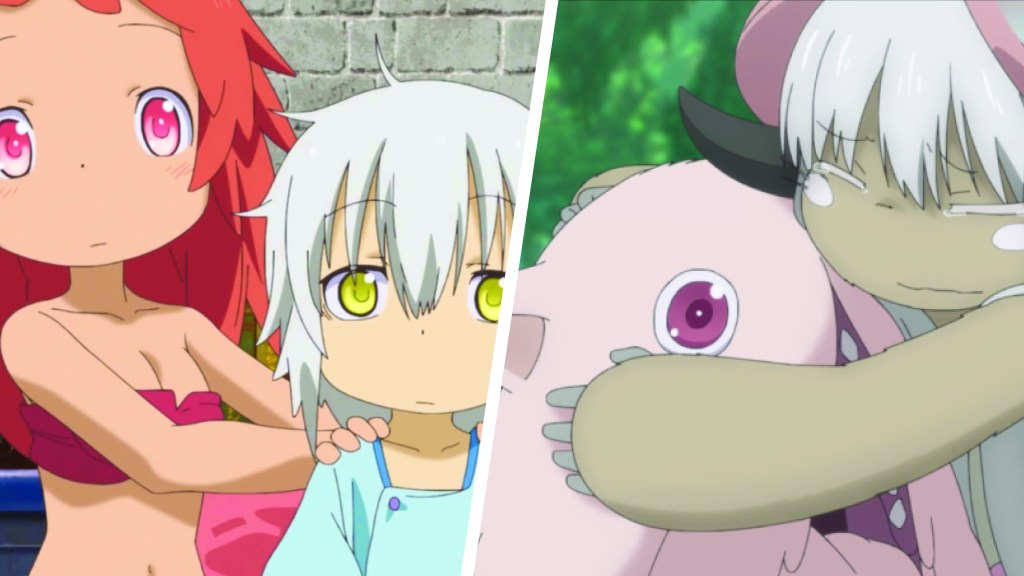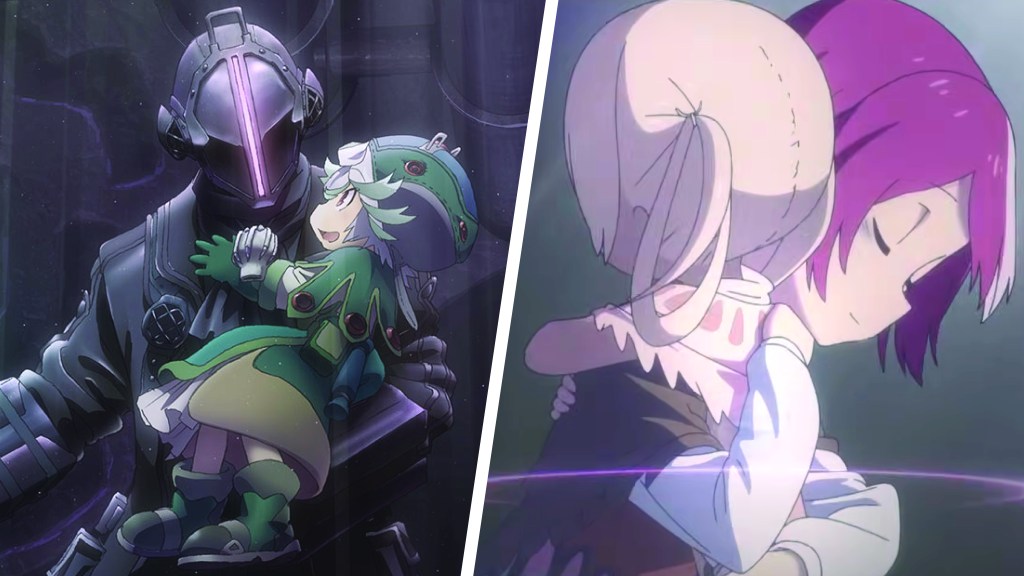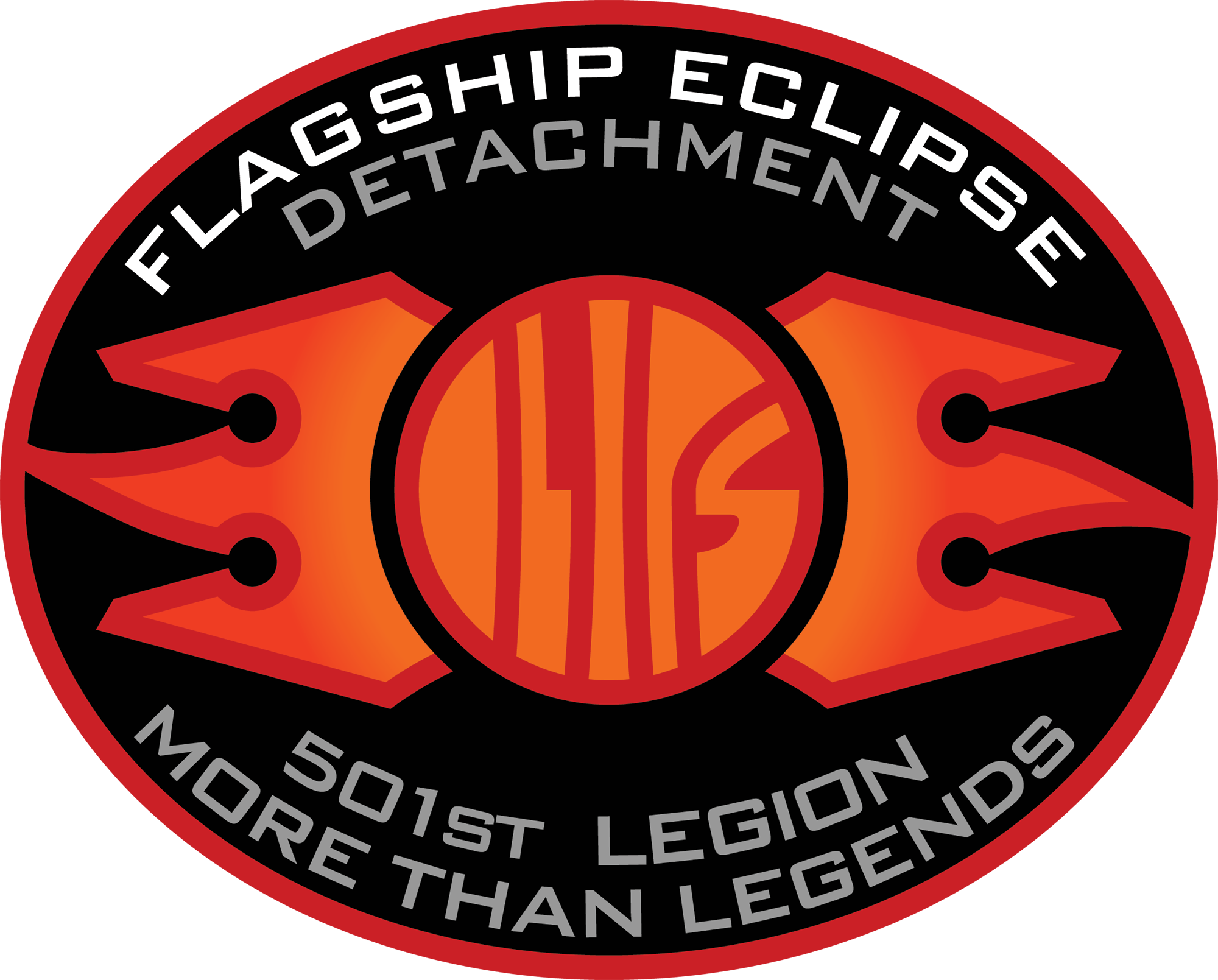
On a remote island live the citizens of Orth, a city on the edge of a colossal pit known as the Abyss. With otherworldly creatures, ecosystems, and treasures adding to the mystery of this strange vertical landscape, both travelers and locals have spent millennia trying to uncover its secrets. When Riko, a rookie-ranked Red Whistle Delver, happens upon a mysterious robot boy, Reg, she becomes inspired to venture to the bottom of the pit in search of her elite White Whistle missing mother. She and her new friends must have the courage to face the dangers of the chasm threatening to swallow them.
While Made in Abyss may initially look like a cute chibi adventure for kids, this anime definitely isn’t for the faint of heart even as an adult. Although the main characters are only children, the story follows their adventure down the colossal pit, the monsters and enemies growing ever more dangerous and malicious the deeper they go. But as they face the harsh reality of innocence lost, they also face the existential question of the meaning of value along the way.
Spoiler Warning for Made in Abyss!
A “Cute” Anime That’s Not for the Faint-Hearted

As stated, don’t let the chibi appearance fool you — its cute veneer only adds to the horrific, harsh reality the characters face that gets more grim as though traveling downward into Hell itself. And while the strange alien environment becomes more gut-wrenching and despairing as they travel downward, the same can be said quite literally should they attempt to retreat and ascend toward the surface; with the Curse of the Abyss being known to cause more and more severe maladies the further one gets from the chasm opening, these afflictions can become fatal, even beyond physical ailment with some delvers even losing their humanity.
Gore, violence, and unspeakable, mind-shattering atrocities; with the compiling traumas these literal children face, its no wonder why many see Made in Abyss as controversial. Death, child experimentation, mindless carnage, emotional trauma, complete mental collapse — the list of horrors are numerous. The absolute savagery that the Abyss throws at anyone unfortunate enough to traverse it is actually astounding in how many ways, whether physically, emotionally, or mentally, one can have their sense of self absolutely eviscerated.

The Abyss Transforms the Body, Mind, and Heart
The Abyss’s cold, unfeeling beasts vary in how they choose to eviscerate their targets, from gargantuan, alien creatures that pluck other residents without thought like fruit off a tree to diabolical, calculating monsters who were once human themselves. And in facing all these threats, although Riko and her friends never waver in their resolve to make sure they get to their goal alive, they discover how the Abyss has not just transformed how other residents look, but how their minds have unraveled in the brutal landscape.
Along the way, Riko and her protector and companion Reg come across Nanachi and Mitty, two Hollow children living in the fourth layer. Hollows, or Narehate, comes from the term “narenohate” meaning “the shadow of one’s former self” and are beings who have survived the curse of the sixth layer, having been transformed into inhuman creatures with varying levels of sentience. Although Mitty had all but lost her humanity as a Hollow, Nanachi managed to retain her own sentience. And so, Nanachi is forced to face her own regrets and responsibilities head-on in the eyes of her most treasured friend Mitty.

Values Borne from Love
In the movie Dawn of the Deep Soul, the triad venture to the Ido Front, a research station at the bottom of the fifth layer that both serves as the location for White Whistle Delvers to commit to their Last Dive into the sixth layer and a place where White Whistle Bondrewd conducts experiments to further understand the Curse of the Abyss. There, Riko and Reg learn more of Nanachi and the late Mitty’s origins and how they came to be Hollows through the horrific experiments conducted by Bondrewd. But what made the experiments so horrific in nature besides child experimentation was the fact that Bondrewd found the answer as to how to conquer the Curse of the Abyss and turn it into what he calls a Blessing: valuing genuine love.
In Season 2, The Golden City of the Scorching Sun, the story splits into converging tales of both the present journey of Riko and her friends and the past journey taken by the Ganja suicide corps, an outcast group of travelers led by three Sages, Wazukyan, Belaf, and Vueko, seeking the legendary Golden City supposedly laying at the bottom of the Abyss. Guided by a young native girl, Irumyuui, they eventually discover a curious artifact known as the Cradle of Desire, aka a Wish-granting Egg. Wazukyan, determined for their survival, gave the item to Irumyuui and, through much pain and suffering, she quite literally gave birth to the village of Iruburu. But, again, the one thing that managed to both cause heartache yet conquer the Abyss was a desire borne from love.
[Related: Made in Abyss Season 3 Announced]

What Do You Value?
When Riko, Reg, and Nanachi reach the strange village in the sixth layer, they meet the Narehate Majikaja who helps explain how the village functions through their value-based economy, how they value fair and equal exchange, and even trading outside of what is considered typical currency. “Every Narehate’s body more or less took on the form of their desire”. Each of the inhabitants trade based on what they each personally value, whether it be certain items, creatures, or even scents. But something they all seem to gravitate toward and value from the newcomers is humanity itself, wanting even a physical piece of Riko to satiate their core desires, much to the pleading of Majikaja for Riko to not damage her own value.
Along with meeting the original founders of the city, when Riko meets an inhabitant named Maaa, she learns just how seriously the importance of value is taken when she witnesses the consequences of even accidentally defying the rule of equivalent exchange or damaging another’s value. Meanwhile, Reg reunites with someone unfamiliar to him: Faputa, the final child of Irumyuui and dubbed the Princess of the Narehate. Although Reg’s memory of Faputa is fuzzy at best, Faputa insists that Reg is her “Haku”, or something of the very highest value; the manifestation of a wish; “the shape of a soul”; “that which is irreplaceable”. Majikaja describes Faputa herself as “the embodiment of Value”.

To Value is to Survive
Value becomes more and more pertinent as a living, breathing phenomena to anyone traversing the alien environment. As an initiating force, Riko values her mother and the idea of adventure itself to take an irreversible chance to journey into the Abyss. Reg values knowing his origin. Nanachi values Mitty enough to end her friend’s suffering. Bondrewd valued progress a little too much to do whatever it takes to transform a Curse into a “Blessing”. Vueko valued Irumyuui. Wazukyan valued survival. Irumyuui valued being a mother. Faputa valued Reg and achieving her mother’s desires. The Narehate have a core desire to value humanity.
Throughout such a treacherous journey into the unknown, some characters succumb to more than just the Abyss’s monstrous beasts or fatal conditions. Whether out of survival, progress, or even love, the thing that the Abyss seems to spur into those who choose to delve into it is a permeating sense of value. Not just to ensure survival, but to abide by the rules of the Abyss, making certain sacrifices and discovering what each considers to be their “Haku” isn’t enough to reach certain desires in the Abyss. Like the governing edict of the village of Iruburu itself, there is one thing that each adventurer much value above all else to retain some sense of humanity in such an inhuman environment: the self.
Let us know in the comments what your take on the themes behind Made in Abyss are!
The post This Controversial Anime Taught Audiences Powerful Lessons of Self-Worth appeared first on ComicBook.com.

